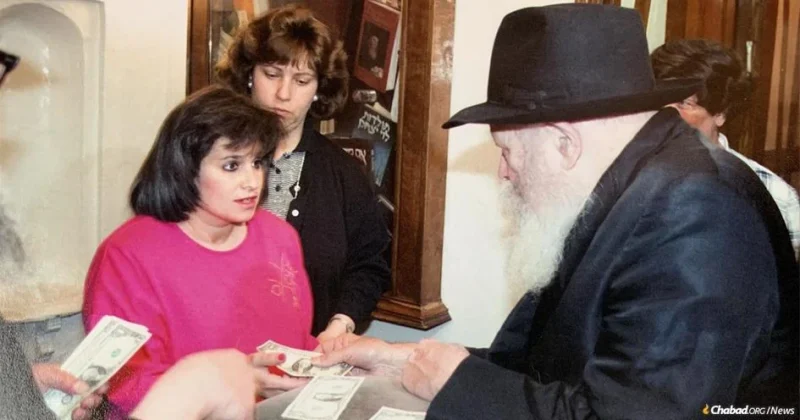
Obituary: Tsevie Gopin, 67, My Mother-in-Law
by Dovid Margolin – chabad.org
The most powerful lessons are the ones taught to us by example. Realizing this now, I am so grateful to my father, who over the course of my childhood I’d hear frequently singing the praises of his mother-in-law, my late maternal grandmother. “I loved my mother-in-law,” he’d say, often to the sniggers of men who did not feel the same about theirs.
This was never meant as some sort of instruction for me. It was just an honest expression of how he felt. I guess that made its mark, because eventually I too grew up, got married, and acquired a mother-in-law of my own.
Well, I loved my mother-in-law, Tsevie Gopin, and will forever miss her warmth, humor, exaggerations, border-line intrusiveness, overflowing love and deep, deep wisdom. She passed away on 13 Menachem Av (the evening of Aug. 6) at the unfairly young age of 67.
I first met my shvigger—Yiddish for mother-in-law, which is what all of us in-laws called her—not as a future son-in-law but as a guest, one of the many thousands who crossed her threshold for a Shabbat or holiday meal. As it turned out, I walked in one Friday night and never left.

Like New York City itself, Crown Heights can be an intimidating place, busy, exciting, overwhelming; that’s just what life is like at the center of it all. To have a place to call home amid all of the action is a relief and a blessing. My shvigger’s home was that to an inestimable number of people: Her hundreds of cousins, nieces and nephews (and then great-nieces and nephews); her seven children’s friends and classmates (and then grandchildren’s); Chabad-Lubavitch emissaries from around the world (and their varied guests); and decades’ worth of other visitors to the neighborhood of the Rebbe, Rabbi Menachem M. Schneerson, of righteous memory.
That’s how I got there. One of her sons was a classmate, and at every opportunity invited large groups of his hungry out-of-town yeshivah friends over for meals, knowing his mother would never object to more people around the table. These meals always turned out to be long, loud, rollicking affairs, full of good food and good wine, words of Torah shared not out of duty but excitement, and first-hand stories of the Rebbe. My mother-in-law, born in Crown Heights when the Lubavitcher community in the neighborhood was still very small, would frequently share memories from her unique vantage point as someone who’d spent her entire life in the Rebbe’s environs.
There was a glowing warmth in the home, the product of the man of the house at one end of the table, the lady of the house at the other, and a large, luminous chandelier hanging over it in the middle. The chandelier and other light fixtures, I later learned, were filled with quasi-blackmarket halogen bulbs that my mother-in-law insisted were infinitely brighter and warmer than LEDs. By now I am convinced she was right, as she was about nearly everything.
She was a balabusta if there ever was one, running her home like a ship. There were grocery deliveries that would make a restaurant chef blush, commercial stocks of plastic goods in storage and emergency pans of ready-cooked meals in the freezers. Also meds. All of them, I think. “Do I know my inventory, or do I know my inventory?!” she’d ask rhetorically. (I imitated this one often.)
But it wasn’t just the food, or the lightbulbs, or the tastefully appointed home on Crown Street, with its warm wood, French Empire armchairs, red couches and sort of golden sheen. It was the all-encompassing, joyful environment created, very much purposefully, by the woman of the house.
“So many of us stayed by you, lived by you and in many ways were raised by you,” one of her many nieces wrote to her during her last days. “At different important stages of our lives, your home was where we were. Young impressionable teens and young adults using your house, your table, your delicious Shabbos food as a backdrop for all the major and minor events in our lives.”

She did not merely allow these events to happen, but more often than not played some crucial role in their formation. Sure, she was a successful match-maker, but that’s not where it began or ended. When a new mother had trouble nursing and her own mother was thousands of miles away, it was my shvigger who walked her through the process. When a young bride needed help and advice setting up her future home, Tsevie Gopin was there to make it happen, literally placing her in a car and taking her shopping. A stylish, well-off society lady, she could have sufficed with sending a check from a distance. Instead, she used her grace, presence, wisdom and money to actively, and discreetly, help people.
During the shiva mourning period after her death, I watched as a Hispanic woman came into the house. She was in tears. “I loved your mommy,” she kept saying. “She was my friend, my close friend.” Iris was my shvigger’s manicurist. Her husband had died at the age of 36, she told us, and during her weekly appointments with my mother-in-law—who’d experienced more than her own fair share of tragedies—she’d confide in her. “I would talk to your mommy, and your mommy would give me strength,” she said. “She gave me tips on how to lead a happy life, how to enjoy the moments of life, how to be grateful for the good.”
At some point more recently, Iris was scheduled to have a surgery. She was nervous about it and mentioned it to my shvigger. “Don’t worry, you’re a strong woman,” my mother-in-law told her. “You’re going to get through this.” Then she asked her if she had enough money for the procedure. “Everything is OK,” Iris insisted. The next day my shvigger walked into the salon and handed her a check. She told Iris it was for the surgery or anything else she might need during this difficult time.
She had a way of keeping an eye out for people, and knowing what it was that they needed. I guess that’s what happened to me. I’d like to say it was my natural charm and good looks that got me noticed as a potential husband for her daughter, but by now I’m pretty sure it was just my mother-in-law’s experience, deep understanding of people, and wisdom that got me hitched.
“See,” she commented to me during our last conversation, “you can like your shvigger.”
Like I told you, the lady was right about everything.

Grapes of the Vine
Obituaries are meant to be about the person, not their entire family history. But it wouldn’t make sense to tell you about my mother-in-law without giving at least some background, both the triumphs and the tragedies—tragedies that could have very easily prevented her from becoming the happy, party-loving woman that she was.
The youngest of six children, she was born Tsevia Deitsch in Brooklyn’s Crown Heights neighborhood on the fifth light of Chanukah, Dec. 21 1957. Her parents, Sholom Yeshaya and Mirel Deitsch, were Lubavitcher Chassidim who’d fled the Soviet Union in 1946 as part of the “Great Escape,” when a nucleus of the Chabad community illegally escaped the USSR. After six years of displacement in Poland, Austria and France, they arrived in the United States in 1952. They lived at first in Norwalk, Conn., where much of their extended family had settled, but moved to Crown Heights in the summer of 1956 so that their children would have a proper Jewish education.

The name the Deitsches chose for their daughter was more than a nod to their distinguished lineage: Tsevia—more commonly rendered Tzivia, though my mother-in-law embraced the idiosyncratic spelling of her name, including for its diminutive, Tsevie—was named for her great-great-aunt, who had passed away months earlier in Hartford. This great-great-aunt Tsevia, who had come to America around 1912 and bucked all trends by retaining her staunch religiosity, was in fact the youngest daughter of the family’s distinguished patriarch, R’ Yekusiel “Kushe,” the melamed from the Belarussian village of Dokshytz (1827-1908). The family took pride in their illustrious ancestor, a noted follower of the Tzemach Tzedek (1789-1866) and two of his successors, and whose name appears a number of times in the recollections of the Sixth Rebbe, Rabbi Yosef Yitzchak Schneersohn, of righteous memory. But they did not allow for their family legacy to remain in the past.
Sholom Deitsch’s parents, R’ Mendel and Hinda Deitsch, were a case in point. Like so many other Jewish refugees, they spent the years of World War II in Samarkand, Soviet Uzbekistan. These were times of great hunger, when people died easily of malnutrition and preventable diseases, and their bodies deposited in mass graves. Amid this privation the couple set up a soup kitchen to feed the hungry. Hinda would collect donkey manure littering the streets, with great effort mix it with straw and form them into cakes, before allowing them to dry in the sun. These cakes, known as a kizyak (kizyaki in plural), were then used to fuel the oven upon which Mendel prepared a large pot of soup each day.
“From the yard were lines of people with bowls in their hands … ,” Mirel Deitsch wrote in her unpublished memoir. “Mendel would cook large vats of soup and distribute bowls of it in the yard to all the hungry. In the meantime, Hinda would go to the hospitals, find the Jewish patients and give them pieces of bread she’d acquired, by hook or by crook.”
So determined a woman was Hinda, that in 1944, when her son Sholom—at the time Mirel’s fiancé—was in a Russian military prison camp in Siberia, she traveled 1,500 miles to the camp, cleaning filthy train station bathrooms to procure tickets for each new leg, to spend Passover with him. Once a robust woman, she returned from the grueling trip weighing 75 pounds, but as Mirel recalled, quickly recovered so she could return to her work “helping the poor and the sickly.”
Later that year, Mirel herself undertook the same trip, bringing along money and tobacco which she left with the camp director as a bribe. She returned to Samarkand in time for Yom Kippur, learning shortly thereafter that Sholom had been freed. The couple was married by Sukkot, and in subsequent years celebrated their wedding anniversary with a kiddush in their sukkah on the evening of Shemini Atzeret, a grand event that eventually reached legendary status in Crown Heights.
An American Tale
My shvigger knew all of these stories, of course, as well as all of the main characters. But she was an American girl, and grew up in a different, sunnier world than her parents had. America was good to her father, who not long after moving to New York bought a truck and went into the schmatte business. Like any good immigrant, he discovered a niche, buying leftover scraps of material which he then sorted and sold for a small profit. The business did well. There were not too many prosperous Lubavitcher Chassidim at the time, and though Sholom was not wealthy, he used his relative success to help others.
One story will suffice: Some time in the early ’60s, a young Chassidic man decided to try his hand in schmattes as well. He borrowed $300, bought a truck-load of goods, and took it around town trying to sell it. Nobody wanted it. Sholom Deitsch was already established in the business, so the young man drove over to Deitsch’s warehouse on Franklin Avenue and shared with him his difficult predicament. Sholom climbed aboard the truck to examine the goods. It was junk, all of it—Deitsch used the Russian word barakhlo to describe the rubbish to his fellow Russian-speaking younger friend. He then gave him the $300 and told him to unload it all in his warehouse, but not before warning him: “un azelcheh narishe zachen zolstu mer nisht tohn — and don’t do such silly things again.”

A hardscrabble guy with a heart of gold is the way he comes across. Though his father and grandfathers had been scholars, Sholom, born in 1918, just after the Russian Revolution, had been denied a proper Jewish education. What he was missing in scholarship he made up with earnestness, spending hours reciting Tehillim, studying the daily portion of Chumash and Tanya—the latter, per the Rebbe’s suggestion, in Yiddish translation. Distributing loans and charity, often outside of his financial comfort zone, came naturally to him.
The couple did not take for granted their newfound proximity to the Rebbe. Indeed, Sholom was at the Rebbe’s farbrengen gathering in the central Chabad synagogue at 770 Eastern Parkway on the Shabbat his wife went into labor with my mother-in-law. Rather than send someone to the synagogue to alert her husband, Mirel asked a friend to join her and went to the hospital herself.
“They were good years,” Mirel wrote of their early years in America. “The house was bubbling over with dancing and singing and laughing.”
Then the other shoe dropped. In 1966 Sholom Deitsch suffered his first heart attack. Many of my mother-in-law’s childhood memories involved her parents traveling to see heart specialists in Boston. Shortly after Passover of 1969, Sholom had a second heart attack in the middle of the night. Every once in a long while my mother-in-law would recall that terrible time. The Rebbe had by that late hour left his office in 770, and her oldest brother dialed the Rebbe’s home number. The Rebbe’s wife, Rebbetzin Chaya Mushka, answered the phone and relayed the situation to her husband. Though paramedics had deemed Sholom’s situation hopeless, the Rebbe instructed the family to take him to a hospital and call back with an update. When the update came it was a devastating one: Sholom Deitsch had passed away a month shy of his 51st birthday.
Some time after their father’s passing, the Deitsches apologized to the Rebbe for having disturbed him and his wife in the wee hours of the morning. “Fahr a yid vi Sholom Deitsch, farnemt tzeit kein ort nisht,” the Rebbe responded. “For a Jew like Sholom Deitsch, time is of no concern.”
What’s Good Is Good
My mother-in-law was 11 when her father passed away. As is natural, she began acting up in Beis Rivkah, the girls’ school she attended. Being a new orphan, she was getting away with it. One of her older sisters taught in the school at the time, saw what was going on, and pulled her over. “You have a choice now,” her sister told her. “You can either be a victim and be treated specially as a result, or choose to be like everyone else.”
She decisively chose not to be a victim. Over the next few years she excelled in school, enjoyed getting into harmless mischief with her friends, and took more and more charge of helping her mother and keeping the home running.

In 1970, her oldest sister Alta and her husband Rabbi Shlomo (“Schwartzie”) Schwartz moved to Los Angeles as the Rebbe’s emissaries, leading Chabad activities on campus. A few years later, her sister Rochel Leah and brother-in-law Rabbi Gershon Schusterman joined them in California, taking the helm of Chabad’s Hebrew Academy in Long Beach. Mirel, often joined by her youngest daughter, began spending time in sunny California, especially to help out each time one of the two young mothers had a new baby.
Then tragedy struck. On the evening of July 31, 1977, Alta collapsed dancing at a wedding in Los Angeles. Efforts to revive her failed. She was 29, and left behind seven young children.
Fast-forward nine years, to 1986, and the unthinkable happened—again. My mother-in-law’s second sister, Rochel Leah, had just finished playing piano at her school’s Passover production when she suffered an apparent heart attack and passed away. She was 36 and left behind 11 children, the youngest 16-month-old twins. A popular teacher in Long Beach, she was mourned by thousands of students.
In the aftermath of Sholom’s death, the Rebbe had counseled Mirel and the family to strengthen their trust in the Almighty, explaining that more trust (bitachon) would allow them to be joyful. Following Rochel Leah’s death, Mirel had likewise written to the Rebbe, asking something along the lines of how could G‑d have done this.

“It is simple that there is no time at all for this,” the Rebbe responded in a Hebrew note, “for the efforts of each and every one of them [i.e., Mirel and her surviving children] should be to sweeten the lives of the orphans and the life of the widower, and not investigations into the ways of the Almighty.”
Rather than wallow in the tragedy of what had occurred, the Rebbe counseled that they focus their energies on the practical work they were actually needed for. Trust in G‑d, focusing on the good, putting yourself into the work of bettering someone else’s life, these were very typical of the Rebbe’s outlook on living a healthy and productive life in the face of challenges large and small. As he wrote in one typical correspondence on the subject, as quoted in Letters for Life: Guidance for Emotional Wellness from the Lubavitcher Rebbe (Ezra Press, 2024): “The type of lives we live, whether full of satisfaction and meaning or the opposite, depends in large measure on our will, which dictates whether we focus on the positive or the negative.”
Taking the Rebbe’s advice to heart, from a very early age my mother-in-law chose to focus on the positives in her life, which she felt was a full and rich one. This manifested itself in the way she “sweetened the lives” of her sisters’ orphans, her very large extended family and the countless other people she interacted with over the decades.
Her modus operandi didn’t change when the pain in her life was further compounded by the untimely deaths of her two oldest brothers in 2006, nine days apart from each other. I married into the family less than four years later, and though she missed her family members very deeply—actively and shamelessly lobbying for new grandchildren to be named after them—she was one of the most joyful people I knew. “We were laughing hysterical!” she’d typically declare after a get-together with her friends. (I mimicked this one too.)

Doing What’s Right
In 1979 she married my father-in-law, Gavriel Gopin, who joined her family’s textile business and came to embody the figure of a Chassidic businessman. Even after leaving the world of the yeshivah he continued to hold a full schedule of Torah study and be active in the Rebbe’s mitzvah campaigns—with an emphasis on the Mezuzah Campaign—all with his wife’s active encouragement. Together, they became active financial supporters of Chabad causes large and small.
Before her marriage and for several years after, my mother-in-law was a much-loved elementary school teacher in Beis Rivkah. After her passing the family received many warm notes from her old students, who remembered her fondly all these years later. She also spent years teaching piano, which she loved to play. In the last few years of her life, when she wasn’t always feeling so great, she taught Judaics at Sparks High School, a small alternative girls’ school in Crown Heights founded and run by two of her daughters, my wife Chaya among them.
She was generally very proud of her children, as she was of her in-laws, whom she treated like her own. My mother-in-law printed out every article of mine to read, and liked all of them. It was as if I could do no wrong in her eyes—at least as far as the writing went.
To all of her children she taught resilience and the importance of hard work. Not that she didn’t sometimes spoil them, regularly giving them presents on her birthday and at other non-traditional times. (She herself was a minimalist who convincingly appreciated the presents she received before promptly regifting them.) She loved Judaism, the Chassidic life and the Rebbe, and gave this love over to them as well.
She was a conscientious mother, providing her children with a stable and loving home while making sure to tend to each of their unique needs. She did the same for her grandchildren, whom she treated as individuals and not a gaggle; a not-insignificant part of her day was spent saying Tehillim for each of her children, in-laws, grandchildren and great-grandchildren.

Maybe that’s why they all happily spent inordinate amounts of time in her home, whether stopping by on the way to or from school, Thursday evenings for supper, or Shabbat afternoons. Of course, Bubby’s house was the number one destination for runaways, who knew they’d get black and white cookies and a therapizing ear.
Into this happy home she welcomed visitors to the Rebbe’s environs, offering them a meal, a bed, and conversation—very often all of them and then some. They would enter her neat, clutterless home and be dazzled. For example, I had no idea what a crumb scraper was before meeting her.
Lots of people host guests, but not all of them give of their time to sit around the kitchen table, and make them feel truly welcomed and cared for. I don’t want to make my shvigger sound like some kind of overly sweet saint, because she wouldn’t have liked that, and it wouldn’t be true. The truth is she did not always appreciate her guests’ constant presence, nor all of the conversations that she had to hold. But that wasn’t the point. You don’t always do what you enjoy, you do what is right.
And somehow, she always knew what that was. She never forgot the small things, whether sending a vendor a warm thank you or remembering other people’s special milestones, and she knew about the big things, too. That’s why so many turned to her for advice—couples, singles, parents about their children, children about their parents. She just knew.
She was one of those wise Jewish women without whom the world would crumble. And if someone like that doesn’t deserve an obituary, I don’t know who does.
Tsevie Gopin is survived by her husband, Gavriel Gopin, and their seven children: Shula Winner (Brooklyn, N.Y.); Raizel Rosenfeld (Aventura, Fla.); Shaya Gopin (Kingston, Pa.); Mendy Gopin (Brooklyn, N.Y.); Chaya Margolin (Brooklyn, N.Y.); Rochel Hildeshaim (Brooklyn, N.Y.); and Chana Baumgarten (Lauderhill, Fla.); in addition to many grandchildren and great-grandchildren. She is also survived by her brother, Avraham Moshe Deitsch.













